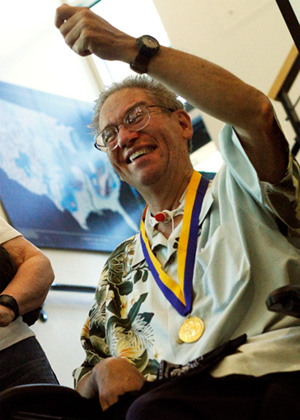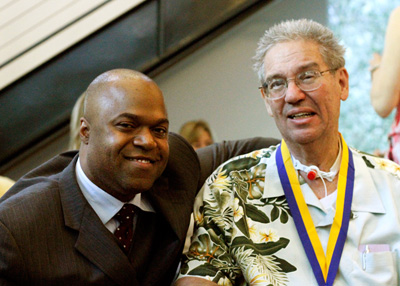Astronomer Jerry Nelson received the Franklin Institute's 2012 Benjamin Franklin Medal in Electrical Engineering in a ceremony at UC Santa Cruz on Friday, June 8.
The Franklin Institute Awards are among the oldest and most prestigious comprehensive science awards in the world. Frederic Bertley, vice president for science and innovation at the Franklin Institute, traveled to UC Santa Cruz to present Nelson's medal to him in person. Nelson, a professor of astronomy and astrophysics at UCSC, was unable to travel to the Franklin Institute in Philadelphia for an awards ceremony and related events in April.
UCSC Chancellor George Blumenthal and astronomer Sandra Faber both shared memories of working with Nelson over the years in remarks before a large crowd of astronomy faculty and students at the Center for Adaptive Optics. Faber, winner of the Franklin Institute's 2009 Bower Award and Prize for Achievement in Science, joked that the institute "once again has shown excellent taste in choosing award winners."
The Franklin Medal recognizes Nelson "for his pioneering contributions to the development of segmented mirror telescopes." When Nelson first proposed a telescope design in which an array of mirror segments functions like a single continuous mirror, no one believed it could be done, said Michael Bolte, professor of astronomy and astrophysics at UCSC and director of UC Observatories. The powerful twin Keck Telescopes at the W. M. Keck Observatory in Hawaii, each with a 10-meter segmented mirror, have proven the effectiveness of this innovative approach.
"It was so far out there at the time, nobody believed it was possible," Bolte said. "The science impact of the Keck Telescopes has been enormous, and that's just the beginning of the contributions of segmented mirrors. The next generation space telescope and giant ground-based telescopes like TMT [the Thirty-Meter Telescope] will also have segmented mirrors."
Nelson is project scientist for the Thirty-Meter Telescope, currently in the design phase. He suffered a stroke in November, but has been making steady progress in his recovery and remains engaged in the TMT project, Bolte said.
"He's not putting in the 90 hours a week he used to work, but he's still providing vital input to the project, and I can see his energy level increasing. I meet with him every week, and I still consider Jerry to be my brain trust for TMT issues," said Bolte, who serves on the TMT board of directors and science advisory committee. "I think Jerry might be the smartest person I know, and I hang around with a lot of smart people. I'm just always amazed at the breadth of his understanding of science and engineering."
In remarks read on his behalf by Faber, Nelson said that he and his colleagues, Terry Mast and Gary Chanan, encountered many problems in designing a segmented mirror telescope, but they were captivated by the idea. "Every new problem was a new opportunity," he said. "More than anything, we had fun while we were developing the ideas that ultimately became the Keck Telescopes."
More information about the Franklin Institute is available online at www.fi.edu.




